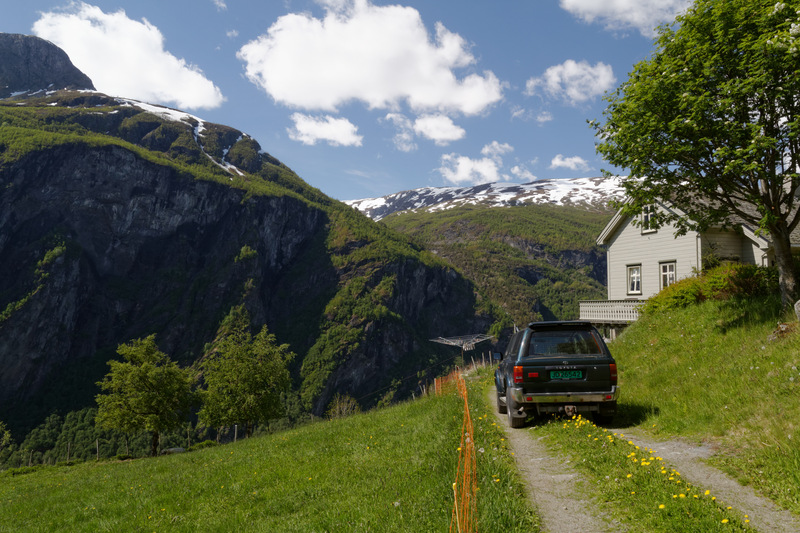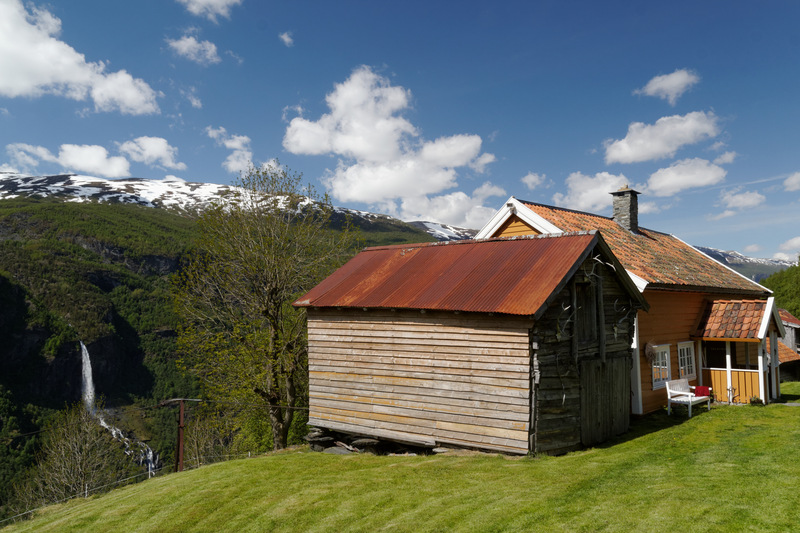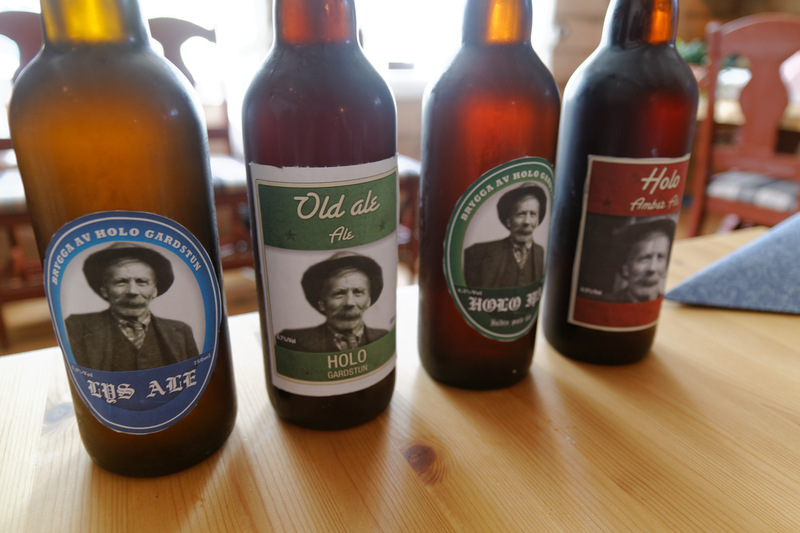Holo Gardstun

Stopping off at Holo |
The Flåm valley sees a huge number of tourists each year. Most either arrive on a cruise ship, or on the Norway in a Nutshell daytrip from Oslo or Bergen. They take the famous Flåm railway up onto the Hardangervidda mountain plateau, then back down again. Quite a few drop by the famous Ægir brewpub. Hardly any spot the treasure that lies hidden on a shelf in the mountain side, several hundred meters above them. (This is part 5 of the Norwegian farmhouse ale trip.)
Holo Gardstun is a small family farm that's now also a kind of restaurant with a small farmhouse brewery. Per Dale, owner and brewer, makes both modern homebrew and traditional farmhouse ale. As with so many of the places we visited, it really aims at bigger groups which reserve in advance. And not really that many of those, either. They have about 400 guests a year.
It's really a family farm, in the same family for generations, now extended to derive some extra income from tourism. Coming out of the car we all look around, then catch our breaths. The view is just impossibly gorgeous. Down in the valley you see the lower parts of the sheer mountains towering over you. Up here the valley floor is mostly hidden and instead we're up among the snow-capped peaks and the forest-covered upper slopes. It gives the impression of being far away in some untouched, remote mountain location, but in reality Flåm is just a 10-minute drive away. Taking a picture of the actual farm is hard, because the hillside is steep, and the farm buildings are tucked into folds in the hillside, as if using them for shelter.

The farm |
Our hosts, Per and Lill Dale, greet us, then show us the brew house. It looks very familiar: wood stove, copper kettle, and so on. The main difference is that it's obviously new. Per explains that they had an original brew house, but it was really run down, and he couldn't show it to visitors. Yet people kept asking to see where the beer was made, so he built a new one. Although new it's obviously intended for brewing the same sorts of beer.

Beer-tasting outside |
We're then lead to a small patch of grass above the farm itself. They've set out a small meal of cured meat for us, as a warm-up to lunch. The sun is sharp and hot. Would we like a beer to go with it? A farmhouse ale from the farm? Yes, actually, we rather would. It's a clear brown beer, at 8.2%, with a beige head. The aroma is earthy caramel and honey. The taste is similar, but with juniper flavours showing, and more fruit. It's very smooth indeed, ending in a softly dry rye crisp bread and fruit finish. A very good beer, clean and strongly flavoured.
It may sound like a fairly modern beer, and in many ways it is. The main differences with a typical imperial brown ale are the juniper, and the boiling over open fire for two hours. The malts, hops, and yeast are all normal, commercial homebrew products. That makes it very, very similar to the beer I helped brew in Sogndal. It's beginning to seem like foreigners wanting to brew an approximation to Norwegian farmhouse ale will be best off with something close to this approach. (You'll find a translation of Per's recipe at the bottom.)

Holo Eldhusøl |
Per learned how to brew from his father, who was very reluctant to teach him, saying he'd forgotten how to brew. Per kept pestering his father, and eventually he gave in. It turned out that he did remember how to brew, but he was not very experienced. Per's grandfather did a lot more brewing and used to have his own kveik, which he collected with a kveikstokk (yeast log) and a straw ring. Sometimes he would even dry it on flatbrød. That yeast strain is now long gone, and Per doesn't think there's any kveik left alive in Flåm.
Per tells us that traditional brewing in the valley started declining after World War II, and that much of the tradition is now dead. Many of the people who now brew in what remains of the tradition use a lot of sugar, and brew with baking yeast. Many of these produce beer that Per doesn't like at all. This, by the way, is a recurring theme on the trip. A lot of people tell us that many traditional brewers make terrible beer. For one reason or another, we never get to try any of it, but people are so unanimous on the subject that we must simply have been lucky.
Having tasted the beer we go inside for lunch, which turns out to be a very substantial affair, where Per's wife Lill, being the cook, takes more of the centre stage. The main course was several kinds of sausage with potatoes and kohlrabi mash. It was really outstanding. I've had these dishes many times, but never like this. We all had difficulties stopping eating, and went on for much longer than we should have. So when the dessert, apple compote, appears, we're in trouble. Especially since that, too, is so delicous it's impossible not to eat it. Eventually we stop, and just sit there groaning.
Then rational thought kicks back in. We're running late, and we've booked dinner in Flåm. We realize that while we can make it to Flåm on time, there's no way we'll be able to eat anything. So, reluctantly, we call the restaurant and cancel.

Per's modern beers |
With the lunch, Per serves us some of his other beers. A pale ale, an old ale, an IPA, and an amber. These are all excellent. Very well made, impressively clean, and very harmonic. Surprisingly, he does not brew these in the traditional brewhouse, but instead shamefacedly admits to using an automated Speidel brewkit. "Laziness, I guess," he says. Lazy or not, the result is impressive.
Eventually, we thank our hosts, and leave. Since we intend to leave on foot, Per comes with us to show us a shortcut. It turns out there is a path that goes down the steep hillside. It's steep and there's barely even a path, so we work up a good sweat just going downwards. It's a sobering thought that this actually used to be Per's daily route to and from school, where his then 90-year old grandfather would pick him up, to walk him back up to the farm.
Having descended 400 or so meters vertically to the road, we walk a few kilometers back to our apartment, drop off some stuff, then walk another few kilometers down to Flåm to visit the Ægir brewpub. After a couple of beers there we walk back to the apartment. By the time we go to bed at midnight we've walked 10-14 kilometers. The "lunch" was so oversized, the idea of having dinner has not even crossed my mind.

Inside the house |
The next morning we have a chat with our landlady before we leave. When she hears what the trip is all about she tells us that, actually, her brother is a traditional brewer. She's sure he would have been happy to meet us and tell us about his beer. So apparently the density of traditional brewers in the valley is still pretty high, even if the actual tradition is somewhat diluted by now.
When she hears what we have to say about the food at Holo she smiles, then starts talking about how she has her own baking house where she serves the guests breakfast. We didn't have time to try that, but it looked really nice. She says she's always happy to give away her recipes, because much more than the recipe, it's who you are and how you approach cooking that determines the result. She doesn't say it, but to me it seems the same must apply to brewing. "Anyway," she finishes, "nobody cooks like Lill Dale!" There's no disagreeing with that.
And on that note we set off in the car, heading for a quite different part of the country: Sunnmøre.
Recipe
As with all of the Norwegian farmhouse ales I've seen to date, Per uses juniper infusion instead of water. He tries to use the thinnest branches, without too much wood or bark, and not too many branches. Some berries may come along, but not too many. He tries to avoid boiling it. As you can tell from the numeric details below, Per is brewing partly in the traditional way, and partly in the modern way.
He mashes at 65-66 centigrade. Sparging at 75-76 degrees, raising the temperature by adding juniper infusion that holds 80-90 degrees. Under the false bottom in the mashing tun he puts a few juniper branches to act as a filter, exactly like Carlo and Sigmund.
He then starts boiling as soon as he has 40-50 liters in the kettle. Boiling is over an open fire, obviously. He boils for about two hours, adding juniper infusion to replace lost liquid.
OG is generally in the 1075-1080 range, while FG tends to be 1015-1020, so the beer is quite strong, around 8%.
He typically starts fermenting at 18C, although temperature probably rises 2-4 degrees at the height of fermentation. Fermentation lasts roughly 2 weeks, before racking to kegs.
As for ingredients, Per kindly sent me the recipe from BeerSmith, so you can see all the details for yourself. BeerSmith doesn't list the juniper and the long open-fire boil, but these are actually key parts of the recipe.
(Martin's blog post about Holo.)
Similar posts
In search of lost time
After I came back from the Lithuanian tour I had a discussion with Martin Thibault about doing the same in Norway
Read | 2014-06-19 12:29
Maltøl, or Norwegian farmhouse ale
This seems like a good time to summarize what I've learned about Norwegian farmhouse ale during and after the May trip
Read | 2014-10-11 13:20
Comments
Ian - 2014-07-31 12:34:05
Fantastic article! It must have been an amazing experience.
I think it's interesting that Per uses S-05 for his recipe. It goes to show that mixing old world traditions with new world technology produces a unique beer.
Cheers, and thanks for sharing!